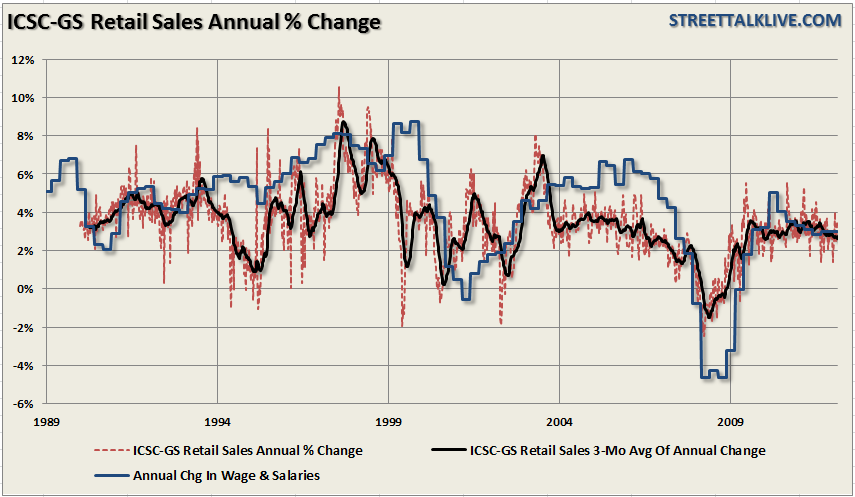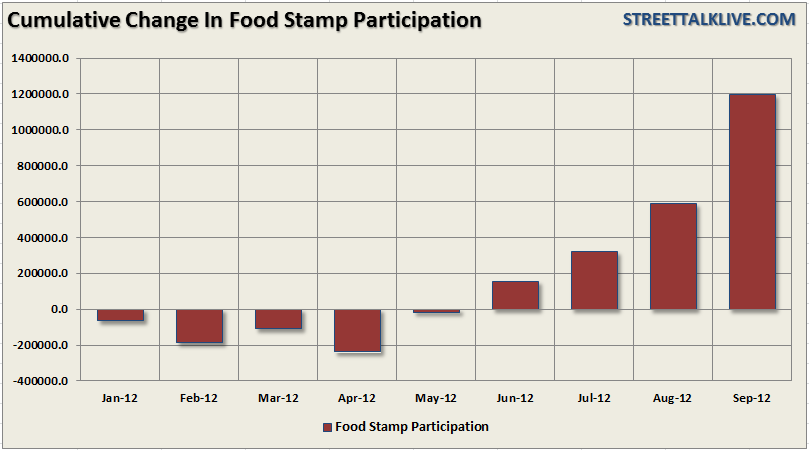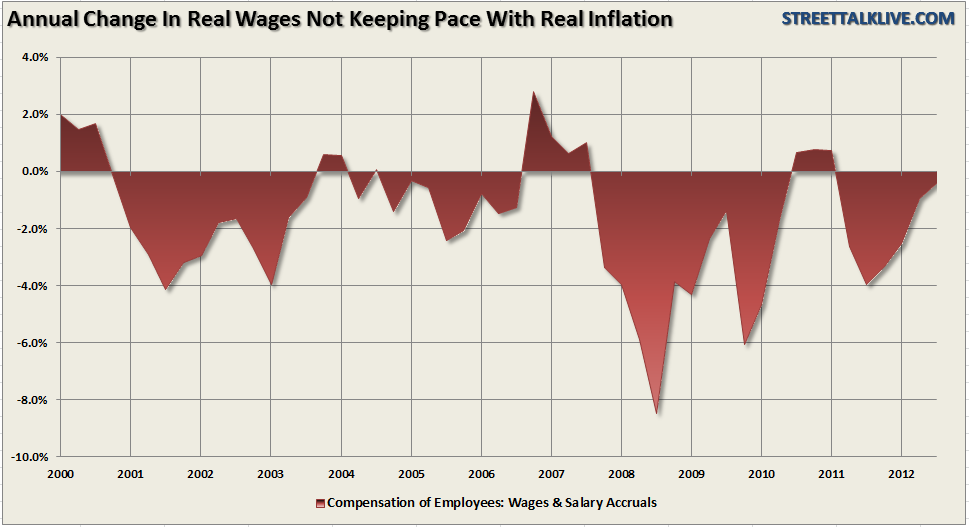Retail sales, as I expected, have turned out to be much weaker than what the National Retail Federation (NRF), and other analysts, previously presumed. The excuses for the weakness, however, were just as much off the mark as the original analysts' estimates. According to an AP article:
Shoppers were buffeted this year by a string of events that made them less likely to spend: Superstorm Sandy and other bad weather, the distraction of the presidential election and grief about the massacre of schoolchildren in Newtown, Connecticut.
The numbers also show how Washington's current budget impasse is trickling down to Main Street and unsettling consumers. If Americans remain reluctant to spend, analysts say, economic growth could falter next year.
While these excuses may play well in the media, in reality, the fiscal cliff, end of October storm and the school shooting had very little to do with retail sales on a nationwide basis. However, what does have much to do with the level of retail sales are incomes.
The chart of day shows the annual change in retail sales which is a very "noisy" data set. I have smoothed that data with a 3-month moving average (black line) and overlaid the annual change in wages and salaries (blue line). 
Not surprisingly when wages and salaries are growing at a slower rate there is a corresponding weakness in the level of retail sales. The peak in wages and salaries occurred in early 2011 with the subsequent growth rate trending weaker. This corresponds with the economy which has continued to muddle along at a very anemic pace.
While it may be likely that the damage from Hurricane Sandy may have soured some sales, particularly in the North East, it is unlikely to have had much of an effect on the retail sales nationwide. For a majority of America the "fiscal cliff" debate largely goes unnoticed as it remains a battle between the White House and the "rich" - for the rest of the country it is more of a distraction from the things that matter like "Honey Boo Boo" and "Housewives Of Whereever".
What does matter though, as stated above, are incomes. The decline in incomes, which can be seen in the roughly 1.2 million person increase in food stamp participation from June to September, is why retail "holiday" spending is weaker. With credit limits reduced, incomes stagnant and real costs of living on the rise - it is not surprising that retail sales are far weaker than the NRF's holiday season predictions. 
While the economy is likely to continue to muddle along in the months ahead, largely due to the impact of $85 billion a month in liquidity from simultaneous QE programs, the strain on the average consumer will remain. This is due to the spread between the annual change in real wages and headline inflation.
This spread deteriorates purchasing power and drags on savings. Of course, you don't need to go much further than your own pocketbook to realize that your cost of living has increased markedly over the last few years even as reported inflation remains low.
While the NRF still predicts that retail sales will clock in with a 4.1% annualized increase, this may still be exuberant. We will have to wait until January to analyze the retail sales data for December, along with revisions for October and November, for a better assessment of the holiday shopping season. My best guess is that expectations are still too high and final numbers could have a negative impact on the retail sector.
- English (UK)
- English (India)
- English (Canada)
- English (Australia)
- English (South Africa)
- English (Philippines)
- English (Nigeria)
- Deutsch
- Español (España)
- Español (México)
- Français
- Italiano
- Nederlands
- Português (Portugal)
- Polski
- Português (Brasil)
- Русский
- Türkçe
- العربية
- Ελληνικά
- Svenska
- Suomi
- עברית
- 日本語
- 한국어
- 简体中文
- 繁體中文
- Bahasa Indonesia
- Bahasa Melayu
- ไทย
- Tiếng Việt
- हिंदी
Chart Of The Day: Retail Sales And Statistical Excuses
Published 12/27/2012, 12:36 AM
Updated 02/15/2024, 03:10 AM
Chart Of The Day: Retail Sales And Statistical Excuses
3rd party Ad. Not an offer or recommendation by Investing.com. See disclosure here or
remove ads
.
Latest comments
Install Our App
Risk Disclosure: Trading in financial instruments and/or cryptocurrencies involves high risks including the risk of losing some, or all, of your investment amount, and may not be suitable for all investors. Prices of cryptocurrencies are extremely volatile and may be affected by external factors such as financial, regulatory or political events. Trading on margin increases the financial risks.
Before deciding to trade in financial instrument or cryptocurrencies you should be fully informed of the risks and costs associated with trading the financial markets, carefully consider your investment objectives, level of experience, and risk appetite, and seek professional advice where needed.
Fusion Media would like to remind you that the data contained in this website is not necessarily real-time nor accurate. The data and prices on the website are not necessarily provided by any market or exchange, but may be provided by market makers, and so prices may not be accurate and may differ from the actual price at any given market, meaning prices are indicative and not appropriate for trading purposes. Fusion Media and any provider of the data contained in this website will not accept liability for any loss or damage as a result of your trading, or your reliance on the information contained within this website.
It is prohibited to use, store, reproduce, display, modify, transmit or distribute the data contained in this website without the explicit prior written permission of Fusion Media and/or the data provider. All intellectual property rights are reserved by the providers and/or the exchange providing the data contained in this website.
Fusion Media may be compensated by the advertisers that appear on the website, based on your interaction with the advertisements or advertisers.
Before deciding to trade in financial instrument or cryptocurrencies you should be fully informed of the risks and costs associated with trading the financial markets, carefully consider your investment objectives, level of experience, and risk appetite, and seek professional advice where needed.
Fusion Media would like to remind you that the data contained in this website is not necessarily real-time nor accurate. The data and prices on the website are not necessarily provided by any market or exchange, but may be provided by market makers, and so prices may not be accurate and may differ from the actual price at any given market, meaning prices are indicative and not appropriate for trading purposes. Fusion Media and any provider of the data contained in this website will not accept liability for any loss or damage as a result of your trading, or your reliance on the information contained within this website.
It is prohibited to use, store, reproduce, display, modify, transmit or distribute the data contained in this website without the explicit prior written permission of Fusion Media and/or the data provider. All intellectual property rights are reserved by the providers and/or the exchange providing the data contained in this website.
Fusion Media may be compensated by the advertisers that appear on the website, based on your interaction with the advertisements or advertisers.
© 2007-2024 - Fusion Media Limited. All Rights Reserved.
